|
German War Memorials
Like many small towns in the U.S. (especially
in the South), many towns and even small villages in Germany have war memorials to their
sons who have fallen in battle. These tend to be more prevalent in Bavaria, and they start
with memorials to the 1866 war of Prussia vs. Austria (when the Bavarians fought
unsuccessfully for Austria). The memorials continue to the Franco-Prussian War of 1870-71
(in which the Bavarians fought on the victorious Prussian side), and on to World War I.
Some of the World War I monuments are large and elaborate, featuring sculptures that are
both expressive and moving. Many towns later added the names of the World War II
casualties to these earlier monuments. It is instructive to note that in many cases, in
contrast to the WWI names, the names of the missing in WWII far outnumber the names of the
dead.
These monuments are the sites for annual
memorial ceremonies, very similar to Memorial Day in America. These services take place on
two Sundays in November - Volkstrauertag and Totensonntag (the last two Sundays
before Advent).
-

|

|

|
This monument honors the dead of
Panzerjäger Abteilung 38 of the 2nd Panzer Division, near the former Ledward Barracks in
Schweinfurt. |
Gedenkstein (Memorial Stone) to
the dead of Panzerregiment 35, 4th Panzer Division, on the
grounds of the former Warner Barracks in Bamberg. |
World War I memorial, to which the
World War II names were added, in Schwemmelsbach, west of Schweinfurt. |
-

|
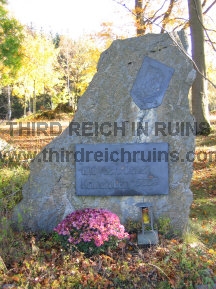
|
On the
left, a Gedenkstein honoring the dead of
Panzerregiment 4, 2nd Panzer Division,
in the Alt Friedhof (Old Cemetery) in Schweinfurt. On the right, a Gedenkstein
to the dead and missing of the 1st SS Panzer Division, Leibstandarte SS
Adolf Hitler, in the Frankenwald. |
-

|

|
These
memorials to the fallen soldiers of the 5th SS Panzer Division "Wiking"
and the 17th SS Panzer Grenadier Division "Götz von
Berlichingen" are in the western part of Germany.
Note - These memorial stones were removed
from this site in 2014. |

|

|
These two memorials
are in the Oberpfalz region of Bavaria. The one on the left is in Speinshart, while that
on the right is in Eschenbach. (both photos courtesy Greg Walden) |
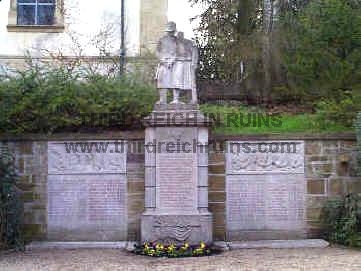
|

|
This monument in the village of
Obbach, west of Schweinfurt, honors the dead of both World Wars. |
A similar monument in the village
of Rieneck, north of Gmünden on the Main River. |

|


|
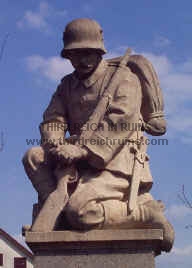
|
Details of monuments
-- left and center - Obbach; right - Rieneck |
|

|

|
|
Grettstadt (left) and
Oberspiesheim (right) - both south of Schweinfurt. |
 |
 |
| The
memorial at Irschenberg in southern Bavaria (left) has a soldier with a
sword and a banner, standing beside a lion, while that in Reiterswiesen
in northern Bavaria (right) features Saint George slaying the dragon
(Saint George wears a German helmet!). |

|

|

|
The memorial in Fuchsstadt, near Hammelburg, has a dying lion similar to the famous
Lion of Lucerne in Switzerland. |
The war memorial in Gräfendorf,
north of Gmünden, also has a dying lion - this
lion has a broken spear in its side and is holding a broken sword in its paw. |
This lion monument at the Gebirgsjäger Kaserne in Berchtesgaden-Strub is
a memorial to German Mountain Troops in World War II. |
|

|

|
| This memorial is
located on a hillside outside the small town of Hilpoltstein, in the
Swiss Franconia region of northern Bavaria. It still looks exactly the
same as when Hitler visited in 1936, with his adjutants Wilhelm
Brückner and Julius Schaub - the only change has been the addition of
side plaques with the names of the World War II dead. ("Adolf
Hitler, Bilder aus dem Leben des Führers," Altona, 1936, (author's
collection) |
|

|

|
| The memorial in
Happurg, east of Nürnberg, features a Classical warrior watching over a
wounded comrade. (The Doggerwerk
tunnel system is located nearby.) |
Monument in the village of
Großeutersdorf, near Kahla in Thüringen; near the site of the REIMAHG
underground Me262 jet aircraft factory. |
-
|

|

|

|
|
This unusual memorial is also
located in Swiss Franconia, in Velden. It is in a natural rock grotto,
and honors soldiers from the Franco-Prussian War, World War I, and World
War II. Note the large Iron Cross. |
As with many other memorials,
these also honor local soldiers from the three recent wars. The center
monument is in Zeuzleben, southwest of Schweinfurt, and the monument on
the right is in Opferbaum, north of Würzburg. |
|

|

|
| Cadolzburg,
west of Nürnberg - a World War I memorial with World War II names
added. |
|

|

|

|
| This elaborate
memorial is in the Bavarian city of Kronach,
just below the castle. The names of the First World War dead are on
plaques in the center of the wall, while the Second World War dead
appear on plaques beneath the sculpted soldiers' heads. (courtesy Louis Lanier
Hurdle) |

|

|
These memorials
are in towns near the Bavarian city of Kronach. On the left, Rothenkirchen,
and on the right, Pressig. (both photos courtesy Louis Lanier
Hurdle) |
|

|

|

|
| This war
memorial and soldier cemetery honors the dead of Bischofsgrün, a small
Bavarian town near Bad Berneck.
(Thanks to Louis Lanier
Hurdle for sending these photos.) |
|

|

|
| Munich,
the capital of Bavaria, has a large war memorial to its fallen heroes of
both World Wars. The memorial is in the form of a recumbent soldier
beneath a large slab, located in front of the old Army Museum building
on the Hofgarten (the building is now the Staatskanzlei). (photos
from the author's collection - see
more photos here) |
|

|

|
| More
period views of the Munich war memorial. The slogan on the slab -
"Sie Werden Auferstehen" - can be translated as "They
Will Rise Again.". (photos
from the author's collection) |
|

|

|
| The
Munich War Memorial, then and now. The postcard on left is labeled "München Kriegerdenkmal" and "Sie werden
auferstehen." (photo on
left courtesy R. Fogt) |
-

|
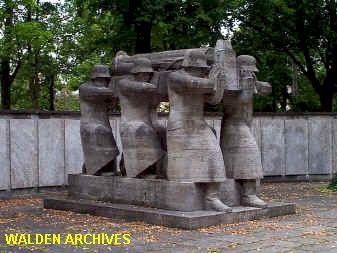
|
This memorial in the Franconian
city of Würzburg honors the dead of World War
I, whose names
appear on the plaques along the rear wall. The memorial was by Würzburg
sculptor Fried Heuler. Crosses were later added at the front of the site
for the World War II dead. (period postcard) |
-


One of the war memorials in Berchtesgaden
is painted above the arcades in the palace square near the Rathaus (town hall). In the
1937 photo above, notice how the right-hand vignette once showed a
Wehrmacht soldier with hand grenades, triumphing over fallen Russian soldiers in winter
suits (see the close-up view below). The
original
1929 painting was by Munich artist Josef Hengge, whose
works were featured in the Haus der Deutschen Kunst,
1941-1944. In June 1945, pursuant to an order by the U.S. military authorities
to destroy all Nazi symbols, Hengge's vignettes were painted over. However,
Hengge himself repainted the memorial in 1952, changing only the right-hand
scene, and adding the dates for World War 2 (the memorial was again restored in
recent years).
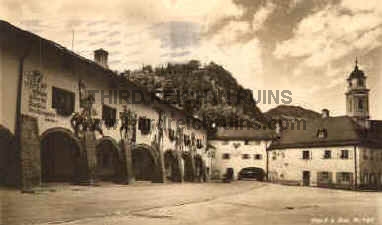
|

|
| Period views of the
Berchtesgaden war memorial. (postcards from author's collection) |
 |
 |
| Left - a
1937-dated postcard view. Right - a close-up showing the right-hand
scene, which was changed when Hengge repainted the memorial in
1952. (from 1945 films of the 101st Airborne Division in
Berchtesgaden, U.S. National Archives) |

This view is from a family photo album
from 1936. (author's collection)

This photo taken by a visiting American
soldier in 1949 shows how Hengge's memorial was painted over in 1945,
except for the central scene. (Westfield Athenaeum Collection, courtesy
Frank Tompkins)

|

|
| Left - GIs from the U.S. 3rd Infantry Division ride past
the Berchtesgaden
memorial on a tank destroyer in May 1945. Right - LTC Kenneth Wallace, 30th Infantry
Regiment, 3rd Infantry Division (on the right), discusses the surrender of Berchtesgaden with the
mayor and other local officials, in the square in front of the war
memorial, 4 May 1945. (National Archives, RG 111-SC,
374710, 204346-S) |

The second Berchtesgaden war memorial is
on the rear wall of the arcade,
behind the arches beneath the painted memorial.
|

|

|
|
Memorial to the dead of both
wars at the church in Oberau, near Berchtesgaden. |
Monument to the dead of both
wars in Hoch-Weisel, near Butzbach
in Hessen. The inscription reads (in part) "We die for you, forget
us not." |
|

|

|

|
|
This very interesting memorial
in the town of Webenheim in the Saarland (west of Zweibrücken) was
erected in 1935 to honor the dead of World War I - the names and dates
for World War II were added post-1945. Rather surprisingly, the Nazi
eagle remains, although the swastika has of course been removed. Below
the eagle appears the title "FÜR DAS VATERLAND GEFALLEN" -
Died for the Fatherland. The memorial is guarded by two larger-than-life
soldier statues, whose faces and helmets now show damaged areas
(vandalism?, 1945 small arms fire?).
(Many thanks to Hugh F. Foster, LTC, USA (Ret.) for sending this
information, and to Greg Pitty for the photos.) |
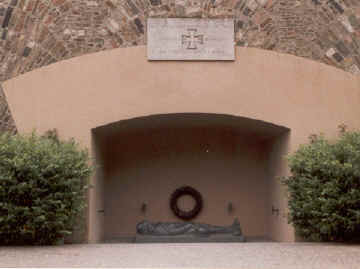
|
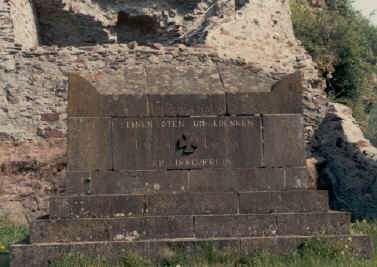
|
| The memorial on the left
is at Ehrenbreitstein Fortress near Koblenz; on the right is a memorial in Mandersheid, in
the Eifel region. (both photos courtesy R. Fogt) |
 |
 |
 |
| The town
of Wilgartswiesen, south of Kaiserslautern, erected this memorial to its
fallen sons of the First World War. The memorial was erected in 1938 and
features typical Third Reich heroic sculptures of soldiers with rifles
and hand grenades, and a soldier with a flag who is leaving his plow and
his wife to go off to war. (photos courtesy Greg Pitty) |
| These
two memorials in Bavaria honor the memory of French Waffen-SS soldiers
who were killed at the end of the war by their own countrymen. I will
not reveal the exact location of these, since left-wing extremists
destroyed the 1st SS Panzer Korps memorial at Marienfels in April 2004.
These 12 soldiers (some sources say 11), French volunteers of the 33rd
SS Grenadier Division "Charlemagne," had been fighting on the
Eastern Front but were in a hospital at the end of the war. They
surrendered and were moving to a POW area, but were stopped by French
forces under Gen. Philippe Leclerc. Declaring them to be "Boche" and
traitors, Leclerc ordered them to be shot, which was done just before
the end of hostilities. Their bodies were left lying on the ground, to
be buried a few days later by American soldiers. A few years after the
end of the war, they were reinterred in the local town cemetery. Their
sacrifice is remembered each year by their comrades and other veterans.
(my sincere thanks to my friend Ralf Hornberger for showing me these
sites)
December 2007 note - Although the Marienfels
1st SS Panzer Korps memorial has apparently been rebuilt in Fretterode
in Thüringen, the first memorial shown below, marking the site where
these soldiers were executed and initially buried, was removed in
October 2007 by local authorities. There is nothing there now but a bare
patch of ground. This is yet another example of the extreme difficulty
that Germany still experiences in dealing with its past.
|
 |
 |
| The
photo on the left shows Gen. Leclerc confronting the prisoners. On the
right is the memorial where they were shot and originally buried. The
memorial wreaths bear inscriptions such as "To Our Murdered
Comrades," "If All the Brothers Remain Silent"
("Wenn alle Brüder schweigen"), "When All Become
Unfaithful, We Remain Truly Faithful," "We Respectfully Honor
the Memory of the Brave Heroes of the Waffen-SS," "Their Honor
Was Loyalty." |
 |
 |
| These
memorials were erected in the town cemetery where the soldiers were
reburied after the war. The plaque with the Fleur-de-Lis has 12 symbolic
bullet marks, and reads "To the Twelve Brave Sons of France,
Prisoners of the Victor, Who Were Executed Without Judgment." |
|

|

|
| This
monument was erected in October 1994 by the survivors of the
Flakbatterie unit stationed at Ettleben, near Schweinfurt.
Ettleben was the site of one of the larger flak positions (three
batteries of six 8.8cm guns each)
that defended the bearing industry in Schweinfurt, and fought the
advancing U.S. Army in early April 1945. |
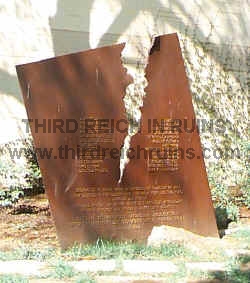
|

|
This monument
was erected in 1998 to the memory of the Schweinfurt
bombing and air battle victims on both sides,
military and civilian. The memorial was sponsored jointly by the Second Schweinfurt Memorial Association (founded to honor
the air crews who fought in the 14 October 1943 battle) and the
association of Luftwaffenhelfer of the local flak batteries. The wording is in both German and English, but while the German
honors all the victims, 1943-45, the English is written only for the
casualties of the
"Black Thursday" attack, 14 October 1943. The monument was erected
beside the largest of Schweinfurt's air defense shelters (Luftschutzbunker). |
-
|

|

|
| This
unusual memorial honors not those who fell in battle, but the
"Deutschen Osten" - the German inhabitants of the eastern
sections of Greater Germany, who were driven from their homes into exile
in 1945, when these parts were taken over by Poland, Czechoslovakia, and
Russia. This memorial is on the site of a Thingplatz
at Bad Windsheim, in northern Bavaria. |
|

|

|

|
| These
memorials also honor the sacrifices of the "Deutschen Osten."
On the left is a memorial to the Sudeten Deutschen of Czechoslovakia,
located in Winkl near Berchtesgaden. At center and right is a memorial
in the Old Cemetery in Schweinfurt, to
the Deutschen Osten of all Eastern European areas, including Russia. |
|

|

|
This memorial of an unusual design
honors World War I soldiers. It is in the shape of an Iron Cross,
laid out as a low wall enclosing a grove of 64 oak trees. The cross is located
on a hillside to the
west of Burgbernheim in northern Bavaria. The cross shape is difficult to see
from ground level, without snow on the ground, but it shows up clearly in
the aerial photo on the right, taken from a balloon. (aerial photo
courtesy Curtis A. Edwards)
|
German War Memorials page - http://www.denkmalprojekt.org/en.htm
(Thanks
to Fred Holst for this link!)
Ewiger Ruhm Page (in German) - http://www.ewiger-ruhm.de/htm/denkmaeler_fr.htm
 Back to the Third Reich in Ruins homepage
Back to the Third Reich in Ruins homepage
|
